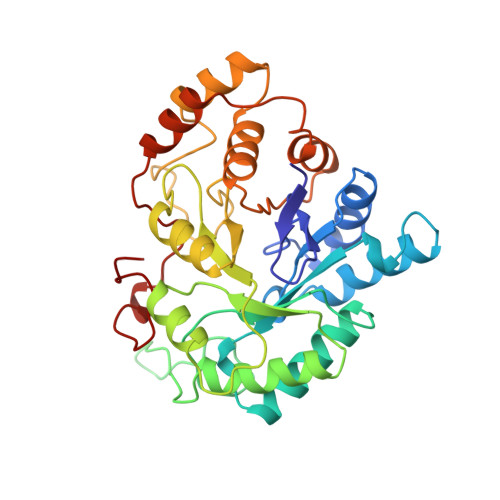1.7 A structure of FR-1, a fibroblast growth factor-induced member of the aldo-keto reductase family, complexed with coenzyme and inhibitor.
Wilson, D.K., Nakano, T., Petrash, J.M., Quiocho, F.A.(1995) Biochemistry 34: 14323-14330
- PubMed: 7578036
- DOI: https://doi.org/10.1021/bi00044a009
- Primary Citation of Related Structures:
1FRB - PubMed Abstract:
Murine FR-1 is a protein that is induced by fibroblast growth factor-1 and, therefore, may play a role in the regulation of the cell cycle. Sequence comparison indicates that it is a member of the NADPH-dependent aldo-keto reductase family. It bears 70% identity to human aldose reductase, an enzyme implicated in diabetic complications and a target for drug design. We have determined the 1.7 A resolution structure of the FR-1 in a ternary complex with NADPH and zopolrestat, a potent aldose reductase inhibitor. FR-1 folds into a (beta/alpha)8 barrel with an active site characterized by a preponderance of hydrophobic residues residing in a deep oblong cavity at the C-terminal end of the beta-barrel. The nicotinamide moiety of the coenzyme sits in the base of the cavity. Zopolrestat occupies the active site cavity and makes numerous contacts with several hydrophobic residues. The FR-1 ternary complex structure indicates that it uses the same general catalytic mechanism as aldose reductase and other members of the family whose structures have been determined. The protein exhibits reductase activity with DL-glyceraldehyde as a substrate and is strongly inhibited by zopolrestat. When compared with the structure of a similar ternary complex of aldose reductase, the binding site retains many of the interactions with the coenzyme and inhibitor from the conserved residues. Some differences in sequence, however, create a larger binding site that contains six more water molecules than in the aldose reductase ternary complex structure.(ABSTRACT TRUNCATED AT 250 WORDS)
Organizational Affiliation:
Howard Hughes Medical Institute, Baylor College of Medicine, Houston, Texas 77030, USA.
















